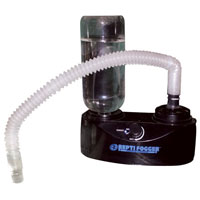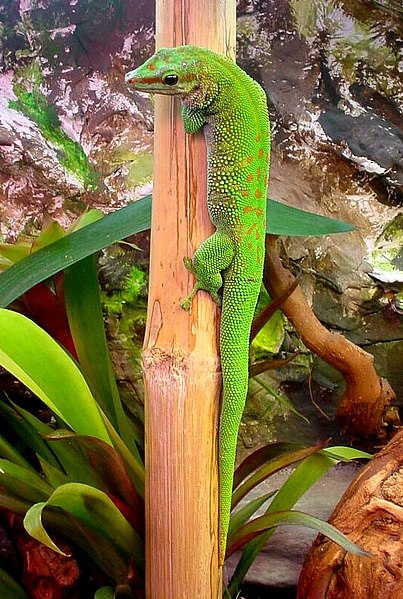Gaily clad in brilliant, neon-hued colors, Day Geckos (Phelsuma spp.) are among the most desirable of all lizard pets, so here is a short article about Day Gecko care. Many are hardy, long-lived, and relatively simple to breed…but only if they are housed in a properly-designed habitat. Active and alert, these cautious animals fare poorly in bare enclosures, but are ideally suited for life in naturalistic, planted terrariums. The security provided by dense plantings and well-placed branches will put Day Geckos at ease and allow you to view a wide range of fascinating behaviors.
Setting up the Terrarium
Day Geckos are highly arboreal and must have climbing opportunities. “High-style” aquariums make fine homes. A pair or trio of Spotted, Yellow-Throated or other small species can be kept in a 15-20 gallon aquarium. A 30-55 gallon tank will accommodate the same number of Standing’s, Madagascar or Giant Day Geckos. Always opt for the largest terrarium possible.
Day Geckos need spacious enclosures that mimic their natural habitat. Live plants such as Pothos and Philodendron will provide visual barriers between tank-mates and a sense of security. Rolled cork bark and hollow bamboo sections make ideal hideaways and perching sites, and should be arranged both horizontally and vertically.
Be sure to establish plenty of basking sites near heat and UVB bulbs, as dominant individuals may exclude others from these important areas.
The terrarium’s screen lid must be tightly secured with clamps.
Substrate
A mix of potting soil, cypress mulch and sphagnum moss is ideal.
Light
Day Geckos will not thrive without a source of UVB light (but some notable exceptions are known; please see article below). Natural sunlight is best, but be aware that glass and plastic filter out UVB rays, and that fatal overheating can occur very quickly.
Your geckos should be able to bask within 6-12 inches of a high-output UVB florescent bulb; the Zoo Med 10.0 Bulb, which I have used at the Bronx and Staten Island Zoos, has been shown to out-perform other florescent models. Mercury vapor and halogen bulbs broadcast UVB over greater distances, and emit beneficial UVA radiation as well. Be sure to provide shaded areas.
A daytime period of 12-14 hours should be established.
Heat
Ambient temperatures of 82-88 F, with a basking spot of 90-95 F, will suit most (please post below for information on individual species).
Incandescent spotlights may be used by day; ceramic heaters or red/black reptile “night bulbs” are useful after dark.
Provide your pets with the largest home possible, so that a thermal gradient (areas of different temperatures) can be established. Thermal gradients, critical to good health, allow reptiles to regulate their body temperature by moving between hot and cooler areas. In small or poorly ventilated enclosures, the entire area soon takes on the basking site temperature.
Humidity
Most Day Geckos are rainforest dwellers and do best in humid surroundings. Their terrarium should be misted at least twice daily. If your home is especially dry, consider using a small reptile fogger to raise the humidity levels in the terrarium (please see photo).
Companions
Males will fight savagely and cannot be housed together. Females are territorial, and must be watched carefully. Pairs, trios (1 male, 2 females) and youngsters may co-exist in large enclosures, but be sure to check dominant individuals do not prevent others from feeding and basking.
 That Reptile Blog – Reptile, Amphibian and Exotic Pet Care and Information
That Reptile Blog – Reptile, Amphibian and Exotic Pet Care and Information




Why a snake’s ‘mental scale’ is called so?
Hi Tania,
Good question…I’m not sure how that name came about…I’ll look into it, Best, Frank
Hi Frank,
I have spent most of the afternoon reading your site and posts, but have not yet found an answer to my question, though I do think I know the answer, I want to ask and be sure…
My daughter sounds a lot like yourself – a true animal lover right from the start, with a deep fascination and love for reptiles, amphibians and fish… Since she was two she has said she would grow up to be a zoologist and veterinarian – preferably at a zoo. Anyhow, currently we have two tanks at home – one a true aquarium with various species, and one a vivarium. The vivarium right now has breeding fancy guppies, snails, cory cats, a pleco, an American toad, a tree frog and a fire belly toad. They have successfully lived together for a couple of years now. My daughter wants to get a bearded dragon and a Madagascar lined day gecko and has now saved up for them. We do have another large tank, but are wondering which ones can live together and which can’t. We are thinking that we could likely put the Gecko in with the toads, but aren’t positive, and that the dragon would have to go alone, but then someone suggested putting the dragon and gecko together… from my understanding, I believe they have pretty different needs in terms of their habitat – can you advise?
Thank you!
Laura
Hi Laura,
Glad to hear of your daughter’s interest…feel free to write if she needs career etc type info in the future.
Yes, Bearded dragons and lined day geckos have radically different needs, and could not be housed together. I wouldn’t put the gecko in your vivarium either…difficult to accommodate them in that type of setting..mixed exhibits are great favorites of mine, but all can go wrong very quickly if you push the limits; I’d leave as is. Following are links to articles on general day gecko and b. dragon care. Please let me know what else you need…search engine on blog is not always accurate, and scanning comments for answers can be frustrating…feel free to post a comment and I’ll answer or send links, best, Frank
http://blogs.thatpetplace.com/thatreptileblog/2013/04/10/day-gecko-care-terrarium-set-up-and-the-best-supplies/#.VFfWTclDV30
http://www.thatpetplace.com/bearded-dragon-article
Hi Frank,
I have scoured the internet looking for an answer to my question but have had no success so I figured I would ask you. I have a lined day gecko in a fully live planted (2 varieties of Pothos, a thriving snake plant, and two other bromeliad-like plants whose name I cannot remember -they start with a d-), self sustaining 12x12x18 tall Exo Terra tank with what I believe is a Zoo Med or Exo Terra tropical UVA bulb and a Zilla 50w mini halogen bulb for heat. There is also a fully established cleaning crew (springtails and isopods). I make sure she has a small condiment cup with Repashy day gecko diet as well as another small condiment cup that I keep filled with fresh water for her (just in case she wants it).
My question is this: in addition to the gecko diet, what would be a good and healthy live food source?I want to provide a live food source as that seems to get the most action out of her. One time, a fairly large fly somehow got into her tank and she spent no less than 30 minutes chasing and hunting it before finally catching it. I would like to be able to provide that same level of engagement and behavior on at least a weekly basis for her but cannot seem to get a solid answer on good liver feeder insects for a lined day gecko. I absolutely abhor crickets due to the increased parasite count, poor nutritional value, odor, and noise. I have tried tong feeding small hornworms but she seems to have little or no interest in them when they are on tongs or in a feeder dish. Ideally, something I can buy somewhat in bulk (25-75 at a time) and just toss in the tank for her to feed off of throughout the week would be perfect but also something that I can get fairly easily if needed to feed multiple times.
Thanks,
Brett
Hey Brett,
Sorry for the extreme delay in responding here. If you would like to receive a response from Frank, you may look him up on twitter @findiviglio or on facebook https://www.facebook.com/frank.indiviglio.9. However, I will attempt to provide some advice based on Frank’s previous articles below.
Frank has personally experimented with adding variation in herp diets and has written a wealth of articles on this very topic. His results were always based on personal experience – I say that because there is a lot of varied opinions on using wild-caught insects specifically. I will list some of his articles below for you to take a look at. Basically, Frank is a fan of supplementing herp diets with various wild-caught insects and invertebrates, assuming they are caught in safe, pesticide-free areas and certain precautions are taken depending on the species. He’s written several articles on how to obtain these free or at little cost (say, with the purchase of a ZooMed Bug Napper).
http://blogs.thatpetplace.com/thatreptileblog/2009/08/17/wild-caught-invertebrates-as-reptile-and-amphibian-food-pesticide-concerns-part-1/
http://blogs.thatpetplace.com/thatreptileblog/2009/05/11/collecting-live-food-for-reptiles-and-amphibians-an-entomologists-technique/#.VuLs1_krKUk
http://blogs.thatpetplace.com/thatreptileblog/2008/07/24/building-a-termite-trap-gathering-termites-as-food-for-poison-frogs-and-other-small-amphibians-and-reptiles/
http://blogs.thatpetplace.com/thatreptileblog/2009/07/24/collecting-live-food-for-amphibians-and-reptiles-pitfall-traps/
Good luck Brett – and once again, sorry for the delay.
That Pet Blog.